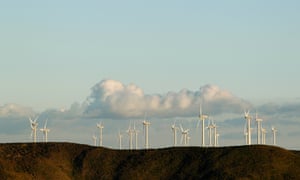We can’t assume the renewable energy boom will simply continue. Only clear, coordinated policy will ensure it does
When
Donald Horne coined the phrase “the lucky country”, he did not mean it
as a compliment to Australians. What he was saying was that we hadn’t
created wealth like other countries – we exploited what was already here
and borrowed from our ancestry.
And Australia has been lucky, because despite a sometimes unforgiving climate, our natural resources are formidable. Over the years we have done well by riding on our gold rush, our sheep and, more recently, through another resources boom.
Globally the next resources boom is already on. For all the noise
about the Adani coalmine, the smart money is now in clean energy. And
here Australia’s luck is in again. We have a lot of sunshine, along with
extraordinary wind and water resources. In time we can genuinely run
our economy on cheap, clean energy that will reduce power prices for
everyone – renters, homeowners, small businesses, manufacturers and
other big energy users.And Australia has been lucky, because despite a sometimes unforgiving climate, our natural resources are formidable. Over the years we have done well by riding on our gold rush, our sheep and, more recently, through another resources boom.
But in order to tap in to this opportunity, we need smarts rather than just dumb luck. We need a clear vision and strategy for managing this transition that will encourage investors to put tens of billions of dollars into new renewable energy and energy storage projects over the next few decades.
This week the Guardian reported on analysis by the Australian National University, which says all the wind and solar projects built over the past few years are reducing emissions. This is but one of the many benefits of the $26bn worth of investment committed in new wind, solar and battery projects in the past two years. But the researchers make the mistake of assuming the unprecedented boom in renewable energy we have seen will simply continue.
Unfortunately, investment in large wind and solar projects has already slowed dramatically over the past six months. Almost the entire business and energy sector is calling for essentially the same thing – an overarching policy that combines action on climate change with a change in the way Australia generates and uses electricity. A range of states have decided to go it alone, because clear and strong national energy policy remains evasive.
"Less bickering and a little more action would be appreciated, after a decade of game-playing and sitting on our hands"
Clean energy can now do everything that coal can do – but cleaner, cheaper and more reliably. We should be agile enough to recognise new opportunities and move to take advantage of them, both technologically and economically. And if we get this right, we can then shift quickly to take advantage of our extraordinary clean energy resources, and begin exporting it to Asia and the world. On this front, the federal government is to be congratulated for its willingness to explore hydrogen as a vehicle for exporting renewable energy. It is a fuel with extraordinary potential to create jobs and growth.
But we have no time to waste. Across the world, the race to become the next clean energy superpower is truly under way. Australia seems to be sitting back and hoping that good fortune will shine upon us again, without the need for smart policy and clever reform to navigate a rapidly-changing investment environment.
The politics of energy and climate has been toxic, with short-term political hits trumping long-term policy to build investment confidence. Unfortunately it is this kind of short-term thinking that Horne was attacking when he first wrote about us as the lucky country. We are still so very, very lucky. But our continued prosperity hinges on us being a bit smarter than we have been in the recent past.
• Kane Thornton is chief executive of the Clean Energy Council

No comments:
Post a Comment